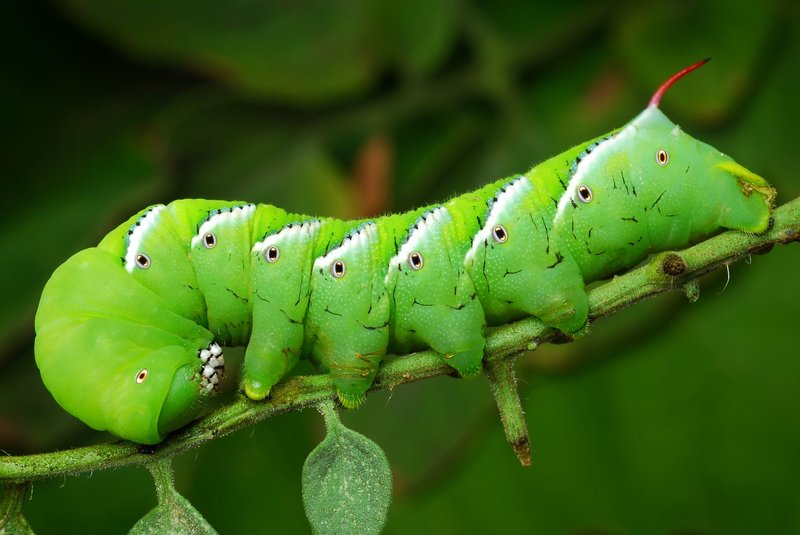
Imagine living in a world where one day it’s scorching hot, and the next, you’re facing a downpour. Like us, hornworms face tough conditions, but they have developed specific behaviors and biological features to keep on thriving. So, let’s dig in and explore how these resilient creatures cope when Mother Nature throws a tantrum.
What Are Hornworms?
Before diving into their survival strategies, let’s clarify what hornworms actually are. Hornworms are the caterpillar stage of certain moths, primarily the tomato hornworm (Manduca quinquemaculata) and the tobacco hornworm (Manduca sexta). These caterpillars are notorious for their voracious appetite and can completely strip plants in a short time.
Hornworms are usually bright green and can grow up to four inches long; you can’t miss them! They have a distinct horn-like structure on their backs, which is where they get their name. But these little guys are not just about eating—they’ve got a survival story to tell.
How Do Hornworms Cope with Heat?
One of the biggest challenges hornworms face is extreme heat. When temperatures soar, these caterpillars have a few clever strategies to keep cool.
First off, hornworms often feed at night when it’s cooler. By munching on leaves after sunset, they can avoid the scorching daytime sun. They’re smart about picking their meals too; young leaves are generally more succulent, making them a prime target for nighttime snacking.
Their bodies are also equipped with a special ability. Hornworms can regulate their internal moisture levels, which helps them deal with dry conditions. When it’s hot and dry, they slow their metabolism and reduce their activity levels. This is similar to how we might avoid heavy exercise on a hot day.
Another fascinating aspect is that hornworms can find shelter in the soil. When the temperatures get too high, they bury themselves into the cool earth, taking a temporary break from the heat above. Think of it as their version of chilling in the shade!
Surviving the Cold
Just like extreme heat, extreme cold can be brutal for hornworms. So how do they handle it when winter rolls in?
Unlike some insects that migrate or die off, hornworms enter a state called diapause as the temperatures drop. Diapause is like a deep sleep where their metabolic processes slow down significantly. This state allows them to survive freezing temperatures by conserving energy and moisture.
They also have anti-freeze proteins in their bodies that prevent their cells from ice formation. This means that while they may look still and lifeless, they are actually working behind the scenes to survive the frost. When temperatures rise again, these resilient critters can wake up and continue their lifecycle.
The Impact of Rain and Humidity
Rain can be a double-edged sword for hornworms. On one hand, it provides moisture that is essential for their survival; on the other hand, heavy downpours can wash them away or drown them.
When it rains, hornworms often seek cover under leaves or burrow into the soil. They’ve got an instinctive sense to identify safe spaces to minimize the risk of getting washed away. Plus, a little rain isn’t all bad; it helps keep their food—especially plants—healthy and hydrated.
Humidity can also be beneficial. Hornworms thrive in moist environments, which can help them maintain ideal moisture levels in their bodies. You might find them in lush, green gardens where humidity is high and water is plentiful.
Dealing with Severe Weather Events
Severe weather events, like storms or unexpected cold snaps, can be tough for hornworms. But these caterpillars have a few tricks up their sleeves.
During storms, hornworms often find shelter beneath large leaves or tuck into soil crevices. They’re masters at sensing changes in their environment. If a storm is coming, they’ll respond by becoming less active and hiding effectively.
After a storm subsides, you might find hornworms emerging to reassess their surroundings. They’ve got a quick recovery plan, thanks to their adaptability. Their resilience is astonishing; they can quickly start feeding again once conditions improve.
Why It Matters for Gardeners
Understanding how hornworms survive harsh weather is not just fascinating; it has real implications for gardeners. For those who grow crops like tomatoes or peppers, knowing how these critters behave can save a harvest.
Recognizing that hornworms have natural behaviors that help them survive can guide pest management strategies. Instead of defaulting to chemical pesticides, gardeners might explore ecological options like encouraging natural predators.
Additionally, being aware of weather patterns can help gardeners take preemptive action. For instance, if a cold snap is expected, covering vulnerable plants can greatly reduce the chances of hornworm damage.
Hornworms are more than just pests; they’re extraordinary survivors that offer insights into resilience in nature. From adapting to heat and cold to handling rain and storms, these caterpillars have a remarkable ability to thrive in challenging conditions.
So next time you spot a hornworm in your garden, take a moment to appreciate the survival strategies behind that seemingly simple creature. They’re a testament to how life can adapt and flourish, even in the face of harsh weather. And who knows? Maybe they’ll remind us to be a little more adaptable in our own lives, too.

